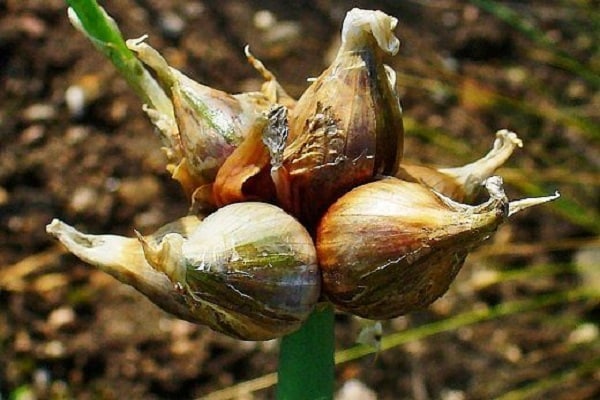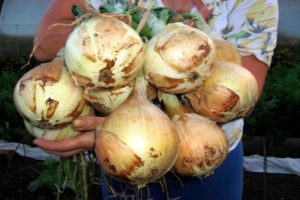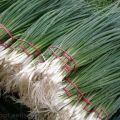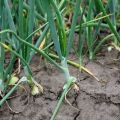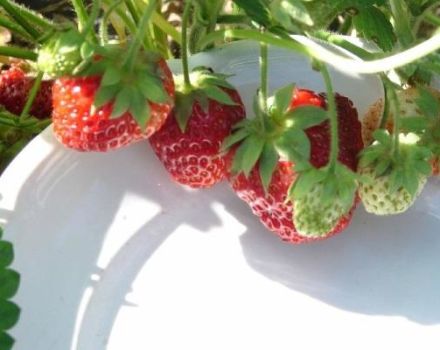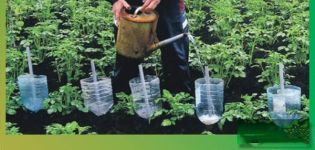Planting, growing and caring for multi-tiered onions
The multi-tiered onion, or viviparous (Allium proliferum) is a perennial herb of the Onion family, which is still quite rare in summer cottages and vegetable gardens. The people also call it Canadian, Egyptian, walking or horned. Despite its exotic and unusual appearance, the vegetable culture is extremely unpretentious in cultivation and care.
Origin and characteristics
The tiered onion is believed to be native to China and is the result of a spontaneous natural hybridization of batun and onions. In an ancient Chinese herbalist dating from the late 14th century, there are references to a plant with similar morphological characteristics called lau-qi-tsun. From East Asia, culture came to the European continent in the 19th century, first to England, then spread to other countries. It was brought to Russia only at the very end of the last century.

Outwardly, the viviparous onion looks like a batun. It also has hollow fist-like leaves covered with a gray waxy bloom, reaching 45-60 cm in height and up to 1.5-2 cm in diameter. The plant produces a flower arrow up to 0.8-1 m long, but not seeds are formed on it, but air bulbs (bulbs). Moreover, the plant is characterized by the formation of several onion tiers (3-4, sometimes 5).
At the first level, the largest onions with a diameter of about 2-3 cm and a weight of about 15-25 g are formed. As you move upward, their size greatly decreases and often does not exceed 3-5 g.
Before the appearance of air bulbs, the leaves have a delicate juicy texture with an original pungent taste and are used for food in a green form. Then they get rough and bitter. Slightly elongated onion bulbs are covered with thin scales of purple, golden or brown color (depending on the variety) and are often used to prepare various pickles and marinades.
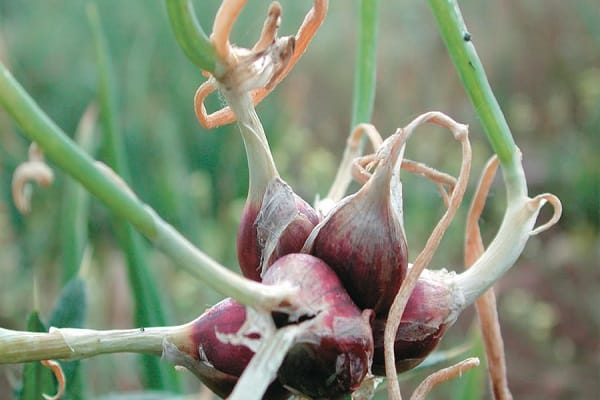
The root system of this plant is powerful and branched, it can go to a depth of 1-1.5 m. The mother bulb located underground is small and loose, unsuitable for human consumption. Over time, it is divided into several parts, which, along with the bulbs, are used in the fall when transplanting or planting a multi-tiered onion to another place.
Breeding features
Aerial bulbs release roots directly on the bush and the plant easily propagates with them, reproduction occurs only vegetatively, since seeds are never formed on this culture. Ripe bulbs are harvested in late summer or autumn, immediately planted in the ground or stored until spring in a cool place. It is not recommended to cut the green feather more often 2-3 times per season, since the future seed (bulb) will be weak and too small.
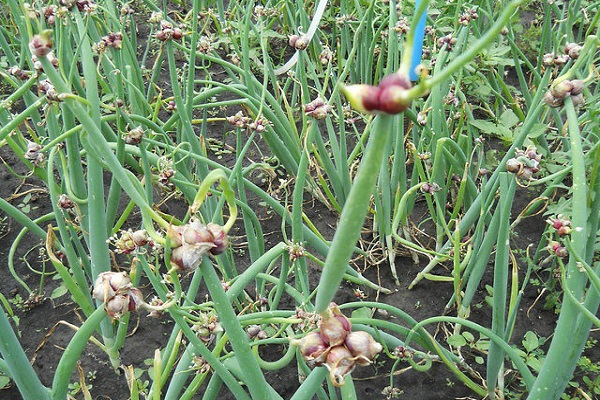
The division of the uterine bulb is carried out at the same time, but it cannot be stored for a long time (due to its loose structure, it quickly deteriorates), therefore, the slices are immediately planted in a permanent place. It is allowed to separate the bush during the entire growing season, otherwise the plantings will thicken strongly.
Requirements for conditions
A multi-tiered onion does not cause any difficulties when growing, it is frost-resistant, as well as drought-resistant and can grow anywhere. But in order to get the first green arrows as early as possible, you need to select rich, breathable loamy soils for this culture. Wet, acidic and heavy soils are not suitable for viviparous onions.
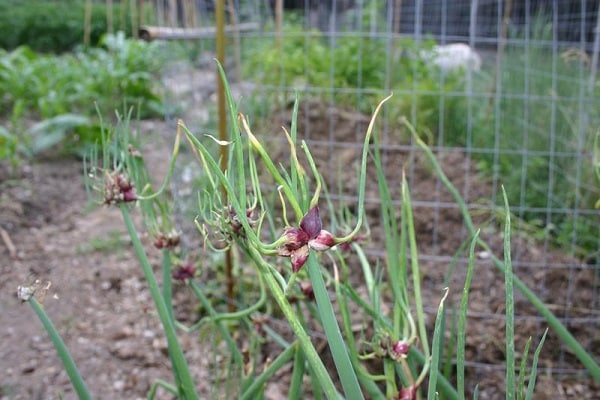
When the substrate is swamped, the underground bulbs quickly rot. A well-warmed and sunlit area is most suitable, from which snow cover early in spring and water does not retain.
An important condition for growing and getting an early harvest will be the timely introduction of organic fertilizers. It is recommended to plant this onion crop after beets, zucchini, potatoes, radishes, cabbage, cucumbers, and legumes.

Growing technology
Viviparous onions have some peculiarities of cultivation; they can be cultivated as perennial and annual. In the first variant, ammonium nitrate (10-12 g), superphosphate (30-40 g) and potassium salt (20-30 g) per 1 m² are added to the ground before planting. In the second case, when digging into the ground, it is necessary to add 6-8 kg of humus or well-rotted manure per 1 m².
To obtain the first early spring greenery, earthen bulbs are not planted; you only need to plant bulbs that have sprouted roots. This should be done before mid-August, otherwise the heads will not have time to root well. At later planting dates, the beginning of the collection of leaves is postponed and the yield decreases. If a plant onions in spring, then the feather for cutting will be ready in about 3-4 weeks.

In open ground, planting material is seated in rows, leaving a row spacing of about 25-30 cm. Large specimens are placed at a distance of 5-8 cm from each other, small ones - 3-5 cm. Depth of planting is from 3 to 6 cm (depending on size). Thickened plantings are further thinned out, using the ground part for food along with the bulb. If you plan to grow a bush in one place for several years, then leave at least 40-60 cm between the plants.
To obtain greenery, you can grow multi-tiered onions on a windowsill or in a greenhouse, while the temperature is not higher than + 10 ... + 12 ° C. Large bulbs and bulbs are planted tightly in boxes with a nutrient substrate and watered regularly. Planting material does not need to be harvested in advance and stored; you can dig a bush right from the garden during the thaw. Fresh feathers reach food grade in 20-25 days.
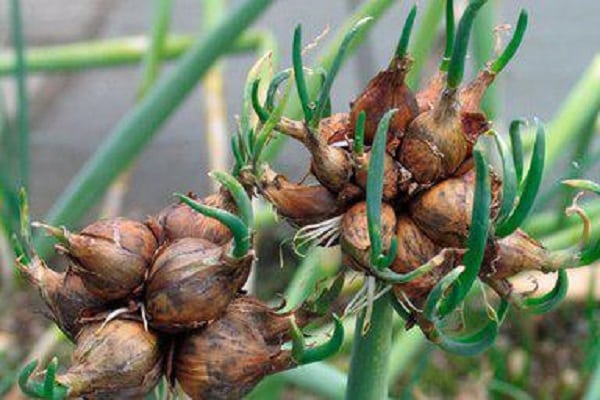
Care features
Caring for onions of all perennial types consists in the following manipulations:
- Loosening. The earth between the rows is loosened once a week to saturate it with oxygen.
- Weeding. Weeds must be removed in time so that they do not take away nutrients.
- Watering. Moistening is carried out after the topsoil has dried out. For 1 m² about 1 bucket of water with a frequency of 10-14 days. Otherwise, in dry weather, the yield decreases, the feather grows poorly, and the bulbs increase slightly in size.
- Thinning. Dense plantings are thinned out, the mother bushes are divided and planted.
- Top dressing. The onion beds need to be fertilized periodically. The first feeding is carried out in early spring in the snow (70-100 g of nitrophoska per 1 m²). Leaves that have grown to 35-40 cm are cut off at least 5-7 cm from the ground, then the bush must be fertilized with potassium salt, ammonia compounds or liquid organic matter.
- Garter. So that arrows with heavy air bulbs do not break, they are tied to pegs or trellises.
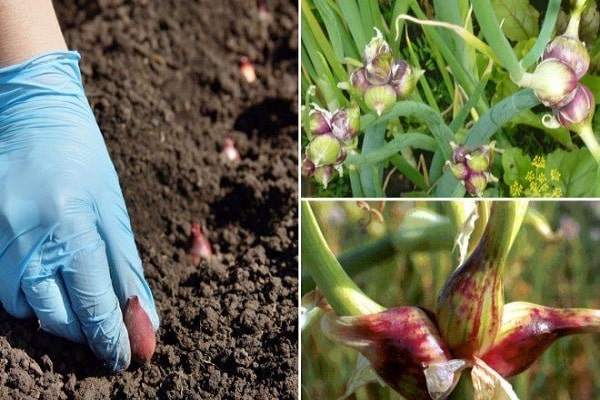
In early spring, as soon as the snow melts, you need to remove all dead plant residues from the site, then feed the onion culture. The plantings are thinned out, 1 head is left in each nest, the rest are seated separately or used for food (this procedure can be performed in the fall before winter). To speed up the growth of cut greens, the onion bed is covered with foil. In this case, a fresh feather will grow 10-15 days earlier, but it will have a lighter color and less pungent taste.
Experienced vegetable growers advise against growing viviparous onions for more than 5 years in one place. This plant gives the best yield in the first 2-3 years of cultivation. Aboveground air heads are collected as soon as basal tubercles appear on them, this time falls on the end of July or the beginning of August. If you do not have time to collect the bulbs in time, then they spontaneously spill out on the ground. Then the arrows turn yellow and dry out. The foliage remains green and fresh until the very frost.
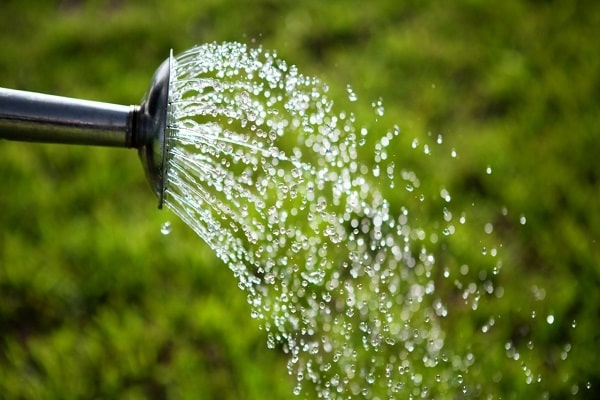
Horned onions are sometimes affected by fungal infections or insect pests, but not more than other onion crops. For prevention purposes, it is recommended to spray the bushes with a solution of Bordeaux liquid (1%) and carefully remove all plant residues from the site. The aisles for repelling insects are sprinkled with ash, mothballs, tobacco dust or hot ground pepper. To get a bountiful harvest, it is necessary to carry out timely and competent care.
Varieties
The varietal diversity of this culture is not too great. The following varieties are recommended for growing in the middle lane:
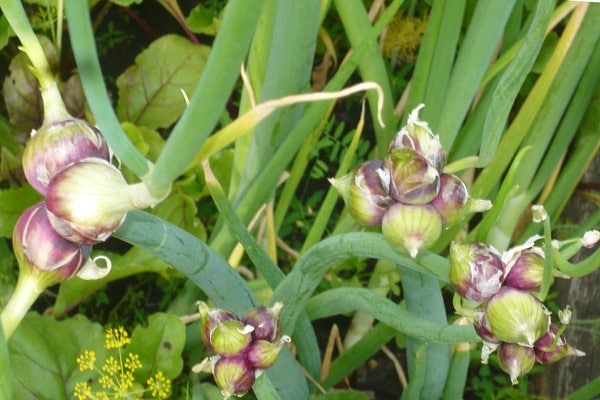
- Gribovskiy 38. The bush is of medium height (up to 0.4 m), dense and compact. A frost-resistant and early-ripening variety of Egyptian onions, zoned for Siberia and the Urals. The first cut of the green feather can be done as early as 21 days after planting the bulb.
- Likova. An early ripening onion with a high yield (up to 4 kg of greens per 1 m²), frost resistance and increased resistance to lodging. Foliage grows up to 0.45 m in 20-25 days, has a pleasant pungent taste. On the arrow, from 3 to 8 large dark purple heads are formed. A small basal onion with an unbranched root system.
- Odessa winter. The feather reaches 0.25-0.4 m in length, the yield is about 2.4 kg per 1 m². Recommended for southern regions. Often shoots in the first year. The number of tiers depends on the climate, weather conditions and how to care for (two-tier is grown in the middle lane, in the south, 3-4 tiers have time to form).
- Memory. High-yielding (6 kg per 1 m²), early maturing, three-tiered variety, with a leaf length of up to 0.44 m. Bulbs of medium size, red-violet color.
- Chelyabinsk super early. The greens are low (up to 0.2 m), tender, juicy and soft, with a pungent taste. For 1 cut, you can collect 1.5-1.7 kg from 1 m².
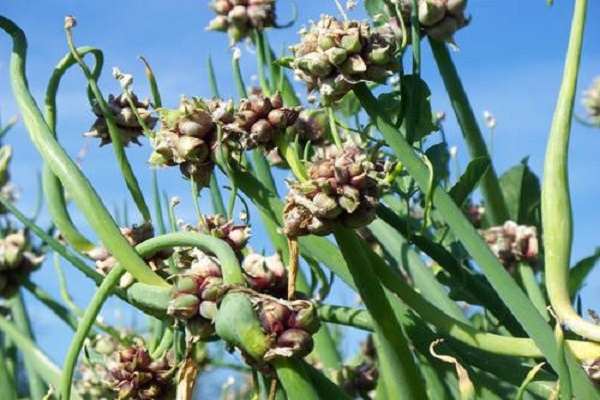
Pros and cons of culture
A multi-tiered bow, planting and caring for which does not cause much trouble, is characterized exclusively from the positive side. It is a very hardy plant that allows you to get the freshest and earliest greens in the open field, in a greenhouse or at home on a windowsill. The bulbs do not need to be dug up in the fall, as they winter well under a little snow cover, even when the air temperature drops to -45 ° C. Since the plant does not have a dormant period, it can be planted at any time.
The leaves and heads of viviparous onions are high in phytoncides and are rich in nutrients. Nitrates and other harmful substances do not accumulate in the green mass of this culture. The plant contains vitamins (C, PP, B1, E, B2), as well as potassium, phosphorus, iron, sodium, manganese and calcium.
